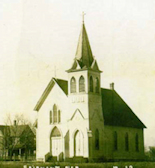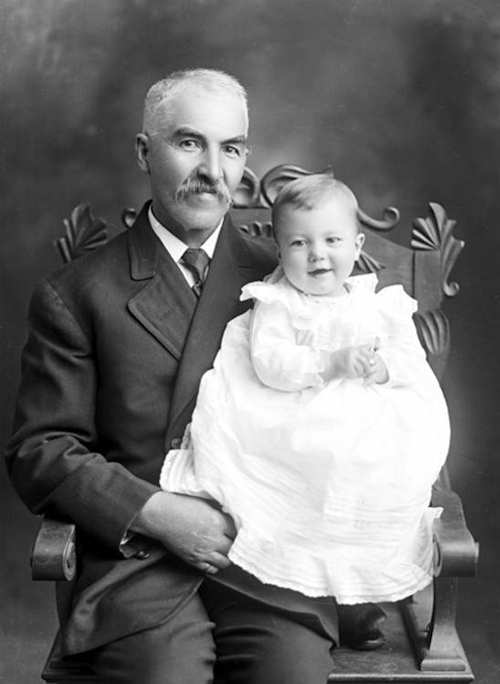At 32,599 square miles, the island that contains the Republic of Ireland and Northern Ireland has just over two-fifths the area of the state of Nebraska. However, it has made a huge impact on the world through the immigration of its people to other places. While the largest diaspora occurred during the potato famines of the 1840s, many Irish continued to move to the United States throughout the rest of the nineteenth century and the early twentieth century. A fair number of them came to Nebraska.

According to
Nebraska Moments by Donald R. Hickey, et al., the very first church built in Nebraska Territory was a Catholic church to serve the Irish population in 1856. Another church purported to have been built for residents of Irish descent some 26 years later was the St. James Catholic Church of Fairmont at left (
Fairmont Public Library Collection). After Germans (a mix of Catholic and Protestant faiths) and Swedes (generally Lutheran), the Irish made up the third largest ethnic group of immigrants to Nebraska.

O’Neill, which has been proclaimed “The Irish Capital of Nebraska,” was named for John O’Neill, who helped establish several towns in Nebraska with Irish settlers. O’Neill, a U.S. Civil War veteran, had worked for “Home Rule” in Ireland, trying to push the British out. Some years later in 1890 that topic was raised in a program at Lincoln High School by the Photereone Society (
Polley Music Library Collection). Along with a mixture of music and dramatics, students debated Irish Home Rule and discussed the issue of Chinese immigration. In two years the Chinese Exclusion Act that suspended Chinese laborer immigration to the United States was due to expire; the Act was renewed in 1892. Some people also wanted to restrict the immigration of other ethnic groups, including the Irish.


The Irish worked at a variety of jobs in Nebraska. William McGaffin, above with his son Wesley (
Butler County Gallery), and his first wife Margery emigrated to the United States in the late 1860s. After spending some years in New York, the McGaffins moved to Butler County, Nebraska in 1885. McGaffin published the
Bellwood Gazette that year and ran the paper into the 1920s. Joseph Haney, at right (
The Lincoln Police Department Collection), was a baby when his family emigrated in 1881. From age 16-20, Haney drove a police wagon for the Lincoln police department. Another Irishman, Captain William T. B. Ireland who was born in New York, served with the Lincoln Police Department for over 20 years.

Whether or not you have descended from those earlier Irish immigrants, you might have enjoyed the St. Patrick’s Day musicale at the Temple Theatre in 1913 with song and dance (Polley Music Library Collection). I plan to enjoy some Irish dancing myself tonight across the street in the newer performing arts center. Enjoy your St. Patrick’s Day!
Visit
Nebraska Memories to search for or browse through many more historical images digitized from photographs, negatives, postcards, maps, lantern slides, books and other materials.
Nebraska Memories is a cooperative project to digitize Nebraska-related historical and cultural heritage materials and make them available to researchers of all ages via the Internet. Nebraska Memories is brought to you by the Nebraska Library Commission. If your institution is interested in participating in Nebraska Memories, see
http://nlc.nebraska.gov/nebraskamemories/participation.aspx for more information, contact
Devra Dragos, Technology & Access Services Director.
 According to Nebraska Moments by Donald R. Hickey, et al., the very first church built in Nebraska Territory was a Catholic church to serve the Irish population in 1856. Another church purported to have been built for residents of Irish descent some 26 years later was the St. James Catholic Church of Fairmont at left (Fairmont Public Library Collection). After Germans (a mix of Catholic and Protestant faiths) and Swedes (generally Lutheran), the Irish made up the third largest ethnic group of immigrants to Nebraska.
According to Nebraska Moments by Donald R. Hickey, et al., the very first church built in Nebraska Territory was a Catholic church to serve the Irish population in 1856. Another church purported to have been built for residents of Irish descent some 26 years later was the St. James Catholic Church of Fairmont at left (Fairmont Public Library Collection). After Germans (a mix of Catholic and Protestant faiths) and Swedes (generally Lutheran), the Irish made up the third largest ethnic group of immigrants to Nebraska.
 O’Neill, which has been proclaimed “The Irish Capital of Nebraska,” was named for John O’Neill, who helped establish several towns in Nebraska with Irish settlers. O’Neill, a U.S. Civil War veteran, had worked for “Home Rule” in Ireland, trying to push the British out. Some years later in 1890 that topic was raised in a program at Lincoln High School by the Photereone Society (Polley Music Library Collection). Along with a mixture of music and dramatics, students debated Irish Home Rule and discussed the issue of Chinese immigration. In two years the Chinese Exclusion Act that suspended Chinese laborer immigration to the United States was due to expire; the Act was renewed in 1892. Some people also wanted to restrict the immigration of other ethnic groups, including the Irish.
O’Neill, which has been proclaimed “The Irish Capital of Nebraska,” was named for John O’Neill, who helped establish several towns in Nebraska with Irish settlers. O’Neill, a U.S. Civil War veteran, had worked for “Home Rule” in Ireland, trying to push the British out. Some years later in 1890 that topic was raised in a program at Lincoln High School by the Photereone Society (Polley Music Library Collection). Along with a mixture of music and dramatics, students debated Irish Home Rule and discussed the issue of Chinese immigration. In two years the Chinese Exclusion Act that suspended Chinese laborer immigration to the United States was due to expire; the Act was renewed in 1892. Some people also wanted to restrict the immigration of other ethnic groups, including the Irish.

 The Irish worked at a variety of jobs in Nebraska. William McGaffin, above with his son Wesley (Butler County Gallery), and his first wife Margery emigrated to the United States in the late 1860s. After spending some years in New York, the McGaffins moved to Butler County, Nebraska in 1885. McGaffin published the Bellwood Gazette that year and ran the paper into the 1920s. Joseph Haney, at right (The Lincoln Police Department Collection), was a baby when his family emigrated in 1881. From age 16-20, Haney drove a police wagon for the Lincoln police department. Another Irishman, Captain William T. B. Ireland who was born in New York, served with the Lincoln Police Department for over 20 years.
The Irish worked at a variety of jobs in Nebraska. William McGaffin, above with his son Wesley (Butler County Gallery), and his first wife Margery emigrated to the United States in the late 1860s. After spending some years in New York, the McGaffins moved to Butler County, Nebraska in 1885. McGaffin published the Bellwood Gazette that year and ran the paper into the 1920s. Joseph Haney, at right (The Lincoln Police Department Collection), was a baby when his family emigrated in 1881. From age 16-20, Haney drove a police wagon for the Lincoln police department. Another Irishman, Captain William T. B. Ireland who was born in New York, served with the Lincoln Police Department for over 20 years.
 Whether or not you have descended from those earlier Irish immigrants, you might have enjoyed the St. Patrick’s Day musicale at the Temple Theatre in 1913 with song and dance (Polley Music Library Collection). I plan to enjoy some Irish dancing myself tonight across the street in the newer performing arts center. Enjoy your St. Patrick’s Day!
Visit Nebraska Memories to search for or browse through many more historical images digitized from photographs, negatives, postcards, maps, lantern slides, books and other materials.
Nebraska Memories is a cooperative project to digitize Nebraska-related historical and cultural heritage materials and make them available to researchers of all ages via the Internet. Nebraska Memories is brought to you by the Nebraska Library Commission. If your institution is interested in participating in Nebraska Memories, see http://nlc.nebraska.gov/nebraskamemories/participation.aspx for more information, contact Devra Dragos, Technology & Access Services Director.
Whether or not you have descended from those earlier Irish immigrants, you might have enjoyed the St. Patrick’s Day musicale at the Temple Theatre in 1913 with song and dance (Polley Music Library Collection). I plan to enjoy some Irish dancing myself tonight across the street in the newer performing arts center. Enjoy your St. Patrick’s Day!
Visit Nebraska Memories to search for or browse through many more historical images digitized from photographs, negatives, postcards, maps, lantern slides, books and other materials.
Nebraska Memories is a cooperative project to digitize Nebraska-related historical and cultural heritage materials and make them available to researchers of all ages via the Internet. Nebraska Memories is brought to you by the Nebraska Library Commission. If your institution is interested in participating in Nebraska Memories, see http://nlc.nebraska.gov/nebraskamemories/participation.aspx for more information, contact Devra Dragos, Technology & Access Services Director. 
